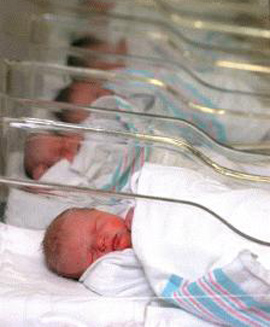Learn About the U.S. > Work and Workplaces in the U.S. > Women > Birth Rates in the United States

|

Women
- Married Women Working in the Post War Era
- Laws Regarding Working Women
- Clerical Work for Women
- Sticky Floor and Glass Ceiling: Barriers to Career Advancement
- Alpha Earners: High Earning Married Women
- Sexual Harassment in the Workplace
- Birth Rates in the United States
- Women in Politics in the U.S.
- Women in the U.S. Military
|

The birth rate has been dropping in the United States.
Photo from South Coast Today.
Birth Rates in the United States
The annual U.S. birth rate—the number of births each year-- has been dropping. In 2002 it was 13.9 per 1000 women, the lowest birthrate since the national birth rate became available in 1909. The most recent peak in the annual birth rate came in 1990, with 16.7 births per 1000 women in that year. The declining the birth rate can be seen especially among teenagers and women in their 20s and early 30s. The birth rate of women between the ages of 35 and 44 is increasing and that of women over 45 has been stable. The decline in the birth rate reflects the increasing number of working women. Many of these working women experience difficulties trying to balance a career and raising children. The first difficulty they may face is that most employers do not offer paid maternity leave. Although the Family and Medical Leave Act (FMLA) provides women with leave for the birth and care of the newborn child, the leave is up to 12 weeks a year and is unpaid. Another difficulty working women face is finding suitable and affordable daycare when going back to work. Click CHARTS to see the annual birth rate in 1990, 1995, 2000 and 2001.
|
|
|
| Download Podcast in
English
| Japanese
|
|
Document |
Audio-Video |
Chart |
Picture |
Map
|
|

